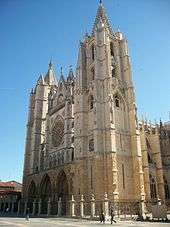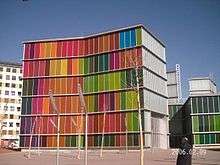León, Spain
| León | |||
|---|---|---|---|
|
León's gothic Cathedral, also called The House of Light or the Pulchra Leonina | |||
| |||
| Motto: Cuna del Parlamentarismo ("The cradle of Parliamentarism")[1] | |||
| Anthem: Himno a León | |||
 León Location of León | |||
| Coordinates: 42°36′20″N 5°34′12″W / 42.60556°N 5.57000°W | |||
| Country |
| ||
| Autonomous community | Castile and León | ||
| Province | León | ||
| Founded | 1st century BC | ||
| Founded by | Legio VI Victrix | ||
| Government | |||
| • Type | Mayor-council | ||
| • Body | Ayuntamiento de León | ||
| • Mayor | Emilio Gutierrez (PP) | ||
| Area | |||
| • Land | 39.03 km2 (15.07 sq mi) | ||
| Elevation | 837 m (2,746 ft) | ||
| Population (2015) | |||
| • City | 127,817 | ||
| • Metro | 202,793 | ||
| Demonym(s) |
Leonés (Spanish) Llïonés (Leonese) Leonese (English) | ||
| Time zone | CET (UTC+1) | ||
| • Summer (DST) | CEST (UTC+2) | ||
| Postal code | 24001 - 24010 | ||
| Telephone prefix | 987 | ||
| Website | Ayuntamiento de León | ||
León (/leɪˈɒn, -ˈoʊn/; Spanish: León [leˈon]; Leonese: Llión [ʎiˈoŋ]) is the capital of the province of León, located in the northwest of Spain. Its city population of 127,817 (2015) makes it the largest municipality in the province, accounting for more than one quarter[2] of the province's population. Including the metropolitan area, the population is estimated at 202,793 (2015).
Founded as the military encampment of the Legio VI Victrix around 29 BC, its standing as an encampment city was consolidated with the definitive settlement of the Legio VII Gemina from 74 AD. Following its partial depopulation due to the Umayyad conquest of the peninsula, León was revived by its incorporation into the Kingdom of Asturias. 910 saw the beginning of one its most prominent historical periods, when it became the capital of the Kingdom of León, which took active part in the Reconquista against the Moors, and came to be one of the fundamental kingdoms of medieval Spain. In 1188, the city hosted the first Parliament in European history under the reign of Alfonso IX, due to which it was named in 2010, by the professor John Keane, the King of Spain and the Junta of Castile and León, as the cradle of Parliamentarism, and the Decreta of León were included in the Memory of the World register by UNESCO in 2013.[3] The city's prominence began to decline in the early Middle Ages, partly due to the loss of independence after the union of the Leonese kingdom with the Crown of Castile, consolidated in 1301.
After a period of stagnation during the early modern age, it was one of the first cities to hold an uprising in the Spanish War of Independence, and some years later, in 1833 acquired the status of provincial capital. The end of the 19th and the 20th century saw a significant acceleration in the rate of urban expansion, when the city became an important communications hub of the northwest due to the rise of the coal mining industry and the arrival of the railroad.
Leon's historical and architectural heritage, as well as the numerous festivals hosted throughout the year (particularly noteworthy are the Easter processions) and its location on the Camino de Santiago, which is ranked as a UNESCO World Heritage Site, make it a destination of both domestic and international tourism. Some of the city's most prominent historical buildings are the Cathedral, the finest example of French-style classic Gothic architecture in Spain, the Basilica of San Isidoro, one of the most important Romanesque churches in Spain and resting place of Leon's medieval monarchs, the Monastery of San Marcos, a prime example of plateresque and Renaissance Spanish architecture, and the Casa Botines, a Modernist creation of the architect Antoni Gaudí. A noteworthy example of modern architecture is the city's Museum of Contemporary Art or MUSAC.
History
Origins
León was founded in the 1st century BC by the Roman legion Legio VI Victrix,[4] which served under Caesar Augustus during the Cantabrian Wars (29-19 BC), the final stage of the Roman conquest of Hispania. In the year 74 AD, the Legio VII Gemina —recruited from the Hispanics by Galba in 69 AD— settled in a permanent military camp that was the origin of the city.[4] Its modern name, León, is derived from the city's Latin name Legio.[5]
The Romans established the site of the city to protect the recently conquered territories of northwestern Hispania from the Astures and Cantabri, and to secure the transport of gold extracted in the province —especially in the huge nearby mines of Las Médulas— that was taken to Rome through Asturica Augusta (modern-day Astorga).[6][7]
Tacitus calls the legion Galbiana, to distinguish it from the old Legio VII Claudia, but this appellation is not found on any inscriptions. It appears to have received the appellation of Gemina[8] on account of its amalgamation by Vespasian with one of the German legions, probably the Legio I Germanica. Its full name was Legio VII Gemina Felix. After serving in Pannonia, and in the civil wars, it was settled by Vespasian in Hispania Tarraconensis, to supply the place of the Legio VI Victrix and Legio X Gemina, two of the three legions ordinarily stationed in the province, but which had been withdrawn to Germany.[9]
That its regular winter quarters, under later emperors, were at León, we learn from the Itinerary, Ptolemy, and the Notitiae Imperii, as well as from a few inscriptions;[10] but there are numerous inscriptions to prove that a strong detachment of it was stationed at Tarraco (modern Tarragona), the chief city of the province.
Kingdom of León
The post-Roman history of the city is largely the history of the Kingdom of León. The station of the legion in the territory of the Astures grew into an important city, which resisted the attacks of the Visigoths until AD 586, when it was taken by Leovigild; and it was one of the few cities which the Visigoths allowed to retain their fortifications.
During the Umayyad conquest of Hispania, in 715 Tariq advanced from the area of La Rioja towards Astorga and León. The same fortress, which the Romans had built to protect the plain from the incursions of the mountaineers, became the advanced post which covered the mountain, as the last refuge of Cisastur Tribes. However, there is no notice of resistance whatsoever. An attempt was made by the invaders to settle the strongholds with Berbers came in a military capacity, but the scheme was abandoned when the Berbers of northern Iberia rebelled against the Arabs and gave up their positions to join the revolt around 740.
Towards the year 846, a group of Mozarabs (Christians who did not flee from the Muslims and lived under the Muslim regime) tried to repopulate the city, but a Muslim attack prevented that initiative. In the year 856, under the Christian king Ordoño I, another attempt at repopulation was made and was successful. Alfonso III of León and García I of León made León city the capital of the Kingdom of León and the most important of the Christian cities in Iberia.
The Kingdom of León started as an independent Kingdom in 910 when the seat of Asturias moved to León, but there was no such thing as an official name change.
Sacked by Almanzor in about 987, the city was reconstructed and repopulated by Alfonso V, whose Decree of 1017 regulated its economic life, including the functioning of its markets. León was a way-station for pilgrims on the Camino de Santiago leading to Santiago de Compostela. With Alfonso V of León the city had the "Fueru de Llión", an important letter of privileges.
The Kingdom of León conquered the Leonese Extremadura under Alfonso IX. After his death his son Fernando III, already king of Castile, joined both crowns in 1230. His son, Alfonso X divided the kingdom again in his testament, but it was not accepted by the King of Castile, who rejoined both crowns. From 1296 to 1301. León was an independent kingdom again, and from then until 1833, when Spain was divided into regions and provinces, the Kingdom of León kept itself as a Spanish Crown territory, whose capital city was León apart from a short period, during which French troops invaded the Kingdom when it was Carracedo.
First democratic Parliament in 1188
In 1188, Alfonso IX of León joined in the city of León all the three states becoming the city in the first European Parliament, developing laws that protected the people. Suburbs for traders and artisans sprang up, who, after the 13th century, began to influence the municipal government. During the early Middle Ages, the livestock industry produced a period of prosperity for the city.
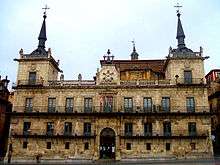
Later history
In the 16th century, economic and demographic decline set in and continued until the 19th century. In July 1936, during the Spanish Civil War, León joined the war against the Republicans.
During the 1960s, León experienced much growth due to in-migration from the rural zones of the province.
In 1983 León was added to the neighbouring region of Castile, to form the Autonomous Community of Castile and León. A popular and local political movement was opposed to being ruled from. Consequently, León is the centre of a peaceful political movement for Leonese autonomy. Some of the Leonese people support the idea of creating a Leonese autonomous community formed by the provinces of Salamanca, León and Zamora, which have traditionally composed the Leonese Region.

Main sights
- Rayonnant gothic Cathedral, with its unique stained glass windows.
- Basilica of San Isidoro, with its tombs of the Kings of León and fine Romanesque paintings.
- Convent of San Marcos (currently a luxurious parador) with a plateresque façade.
- Palacio de los Guzmanes, the site of the provincial diputación (parliament). It contains a patio in the plateresque style by Gil de Hontañón.
- Casa de Botines, a neogothic styled building designed by Antoni Gaudí (one of the three Gaudí buildings outside Catalonia).
- The Walls, built in the 1st century BC and enlarged in the 3rd-4th centuries AD.
- Plaza Mayor.
- Plaza del Grano.
- Barrio Húmedo (the drinking and partying area).
- Palacio del Conde Luna (14th century).
- Palacio de los Marqueses de Prado, a 17th-century Baroque building, currently the Hospital Nuestra Señora de Regla.
- Church of San Salvador de Palat del Rey, the most ancient in the city (10th century), however with few remains of the original Pre-Romanesque building. As the name (meaning church of the "Holy Savior of the King's Palace") suggests, it once acted as royal chapel.
- Church of Nuestra Señora del Merdado, from the 11th century.
- Church of San Juan y San Pedro de Renueva, dating to 1944-1970, but including an 18th-century Baroque façade taken from the ruined monastery of San Pedro de Eslonza, located about 22 km (14 mi) outside the city.
- MUSAC. It is a contemporary art museum which opened in 2005. Its design by the architectural studio Mansilla+Tuñón was awarded with the 2007 European Union Prize for Contemporary Architecture. One of the building's most distinctive features is its façade formed out of thousands of large multicolored stained-glass panels. Close to the museum is the León Auditorium, also projected by Mansilla+Tuñón, which has an equally striking presence of crisp white cubes perforated by irregularly set windows.
- Museo de León, which contains a collection of prehistorical tools and art from the Roman, Medieval and Modern periods.
- Museo Sierra-Pambley, a house from the Age of Enlightenment
- University of León.
Folklore and customs
Leonese customs include the Semana Santa ("Holy Week"), featuring numerous processions through the centre of the city. One of them is the so-called "Procession of the Meeting", which acts out the meeting of three groups representing Saint John, the Virgin Mary and Christ, in the esplanade in front of the old council. Associated with Semana Santa is the procession called "The Burial of Genarín". Genarín was an alcoholic beggar who was hit by and killed by the first garbage truck in the city of León in the year 1929. This is a celebration of alcohol, and the main purpose of the people who attend it is getting drunk in honor to the alcoholic beggar.
The San Juan and San Pedro festivities are also remarkable, celebrated during the last week of June (between June 23 and June 29). During these days several concerts and festivals take place and the whole city is occupied by terraces and street markets where Leonese people celebrate the beginning of the summer, especially on San Juan's night (June 23) when beautiful fireworks and bonfires take place.
Districts
The city of León can be divided into more than 36 districts (barrios):
- Centro or downtown
- Casco Antiguo or Casco Histórico, the historical part of the city
- Área 17
- Armunia
- Cruce de Armunia
- El Crucero
- El Ejido
- Ensanche
- Eras De Renueva
- Ferral
- La Asunción
- La Chantría
- La Lastra
- La Palomera
- La Sal
- La Torre
- La Vega
- La Victoria
- Las Ventas
- Obra Sindical Del Hogar
- Oteruelo De La Valdoncina
- Paraíso-Cantinas
- Patronato Viviendas Militares
- Pinilla
- Puente Castro
- San Andrés del Rabanedo
- San Claudio
- San Esteban
- San Lorenzo
- San Mamés
- San Marcelo
- San Marcos
- San Martín
- San Pedro
- Santa Ana
- Santa Marina
- Santa Olaja
- Polígono 10
- Trobajo Del Cerecedo
- Trobajo Del Camino
- Villabalter
Climate
León features a warm-summer Mediterranean climate (Köppen: Csb). In winter, temperatures normally oscillate between −1 °C (30 °F) and 13 °C (55 °F). Frost is common in the early hours of the morning before the dawn during the coldest days of the winter, but normally melts after sunrise. Snowfalls are not rare in the city (13 days a year), however heavy snowfalls are extremely rare. During spring, temperatures are usually between 10 °C (50 °F) on the coldest days and may easily surpass 25 °C (77 °F) on some days. Summers are very warm and relatively dry, with temperatures usually oscillating between 21 °C (70 °F) and 35 °C (95 °F). However, it's not uncommon for temperatures to reach over 35 °C (95 °F) in the city during the hottest days of summer. The city enjoys a considerable amount of sunshine throughout the year.
| Climate data for León,Virgen del Camino 916m (1981-2010) | |||||||||||||
|---|---|---|---|---|---|---|---|---|---|---|---|---|---|
| Month | Jan | Feb | Mar | Apr | May | Jun | Jul | Aug | Sep | Oct | Nov | Dec | Year |
| Record high °C (°F) | 21.0 (69.8) |
21.5 (70.7) |
25.5 (77.9) |
29.2 (84.6) |
31.9 (89.4) |
36.5 (97.7) |
36.5 (97.7) |
38.2 (100.8) |
37.4 (99.3) |
28.4 (83.1) |
23.4 (74.1) |
19.0 (66.2) |
38.2 (100.8) |
| Average high °C (°F) | 7.1 (44.8) |
9.5 (49.1) |
13.3 (55.9) |
14.8 (58.6) |
18.6 (65.5) |
24.0 (75.2) |
27.4 (81.3) |
26.9 (80.4) |
22.9 (73.2) |
16.7 (62.1) |
11.2 (52.2) |
8.0 (46.4) |
16.7 (62.1) |
| Daily mean °C (°F) | 3.2 (37.8) |
4.7 (40.5) |
7.6 (45.7) |
9.0 (48.2) |
12.6 (54.7) |
17.1 (62.8) |
19.8 (67.6) |
19.6 (67.3) |
16.5 (61.7) |
11.7 (53.1) |
7.0 (44.6) |
4.3 (39.7) |
11.1 (52) |
| Average low °C (°F) | −0.7 (30.7) |
0.0 (32) |
1.9 (35.4) |
3.3 (37.9) |
6.6 (43.9) |
10.2 (50.4) |
12.2 (54) |
12.3 (54.1) |
10.1 (50.2) |
6.7 (44.1) |
2.8 (37) |
0.4 (32.7) |
5.5 (41.9) |
| Record low °C (°F) | −17.4 (0.7) |
−14.4 (6.1) |
−11.2 (11.8) |
−6.1 (21) |
−4.0 (24.8) |
0.0 (32) |
3.0 (37.4) |
2.6 (36.7) |
0.0 (32) |
−3.4 (25.9) |
−7.2 (19) |
−15.4 (4.3) |
−17.4 (0.7) |
| Average precipitation mm (inches) | 50 (1.97) |
34 (1.34) |
32 (1.26) |
45 (1.77) |
56 (2.2) |
31 (1.22) |
19 (0.75) |
23 (0.91) |
39 (1.54) |
61 (2.4) |
59 (2.32) |
66 (2.6) |
515 (20.28) |
| Average precipitation days | 8 | 6 | 6 | 8 | 9 | 5 | 3 | 3 | 5 | 8 | 8 | 9 | 75 |
| Average snowy days | 4 | 3 | 2 | 1 | 0 | 0 | 0 | 0 | 0 | 0 | 1 | 2 | 13 |
| Average relative humidity (%) | 82 | 74 | 66 | 65 | 62 | 56 | 52 | 54 | 62 | 74 | 80 | 83 | 67 |
| Mean monthly sunshine hours | 130 | 161 | 214 | 228 | 259 | 314 | 358 | 327 | 246 | 178 | 137 | 120 | 2,673 |
| Source: Agencia Estatal de Meteorología[11] | |||||||||||||
Transport
Airport
León Airport (IATA: LEN) is located approximately 6 kilometres away from the city centre, in the neighbouring town of La Virgen Del Camino/Valverde de la Virgen. It offers mostly domestic flights within the country, as well as flights to and from Paris, France. Currently two Spanish airlines operate in it: Iberia/Air Nostrum and Air Europa. They offer flights from and to Madrid, Spain, Barcelona, Spain, Valencia, Spain, Palma de Mallorca, Spain, Tenerife, Spain and Paris, France. During the summer months the number of available destinations increases, and flights are also offered from and to Ibiza, Spain, Menorca, Spain, Málaga, Spain and Gran Canaria, Spain.
Railway stations
León has two railway stations, one on the RENFE line, and one on the FEVE lines.
Public transport
Leon has 14 city bus lines, belonging to the company Alesa, a subsidiary of ALSA. Besides the buses, there are plans to introduce tram lines in the city.
Leonese language
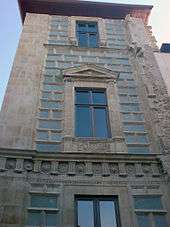
History
The Leonese language derives directly from Latin and developed in the Middle Ages. At this time, Leonese was the official language of the Leonese Kingdom and achieved a high codification grade in the city of Llión.[12] The first written text in Leonese was Nodicia de Kesos (959 or 974); other works in the language include Fueru de Llión, Fueru de Salamanca, Fueru Xulgu, Códice d'Alfonsu XI, ou Disputa d'Elena y María or Llibru d'Alixandre[13]
Leonese is considered a seriously endangered language by UNESCO.[14] It is almost extinct, being known and spoken by only a very few elderly people who live isolated in the mountains of the northern part of the province of León. However, people who wish to separate León from Castile and who support Leonese autonomy are trying to revive the language. León City Council and Leonese language associations like the Asociación Cultural de la Llingua Llïonesa El Fueyu are promoting its knowledge and use.
Leonese Language Day started in 2006 with the support of Leonese Provincial Government, and from 2008 the celebration is organised by the León City Council.
Teaching
At the end of the 1990s, several associations unofficially promoted Leonese language courses. In 2001, the Universidad de León (University of León) created a course for Teachers of Leonese language, and local government developed Leonese language courses for adults. The Leonese Language Teachers and Monitors Association (Asociación de Profesores y Monitores de Llingua Llïonesa) was created in 2008 and promotes Leonese language activities.
Leonese lessons in schools started in 2008, and it is currently taught in sixteen schools in León city in 2008-2009, promoted by the Leonese Local Government Department for Education. This course is for pupils in their 5th and 6th year of primary school (11- and 12-year-olds), where Leonese language is taught with Leonese culture.
More than one hundred people are studying Leonese in adult classes in 2008-2009. There are five levels for adults in the official courses developed by the Department for Leonese Culture of the Leonese City Council.[15]
Government
The Leonese City Council was founded in 1345. It has 27 city councillors.
In the last municipal elections (22 May 2011) the results were:
- Partido Popular - 44.61% votes and 15 councillors
- Spanish Socialist Workers Party (Partido Socialista Obrero Español, PSOE) - 30.99% of the votes and 10 councillors
- Unión del Pueblo Leonés - 6.88% and 2 councillors
The Government of León is composed by the People's Party (Partido Popular). The mayor is Emilio Gutierrez, from the PP.
León is in the county (comarca) of Tierras de León.
Twin towns — sister cities
León is twinned with:
 Bragança, Portugal[16]
Bragança, Portugal[16] Porto, Portugal[17]
Porto, Portugal[17] León (Guanajuato), México[18]
León (Guanajuato), México[18] Voronezh, Russia[18]
Voronezh, Russia[18] Dublin, Ireland[18]
Dublin, Ireland[18] Xiangtan, China[19]
Xiangtan, China[19] Córdoba (Spain)[20]
Córdoba (Spain)[20] Chartres[20]
Chartres[20]
Food
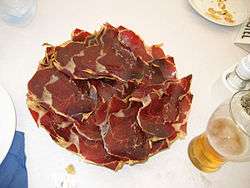
Within the wide range of Leonese cuisine the following dishes are the most representative: cecina (cured, smoked beef), morcilla (a variant of blood sausage), botillo (a dish of meat-stuffed pork intestine), garlic soup, el cocido leonés (a mix of meat with vegetables and chickpeas, served after a vegetable-vermicelli soup) and mantecadas (pastry). Another very important part of the gastronomy of León are the tapas, which are usually given free with drinks, unlike in the rest of Spain. It is very common to go "de tapas" or "tapear" i.e. to go for a few drinks ("un corto", which is a very small beer, "una caña", which is roughly half a pint of beer or "un vino", a glass of wine) just before lunch but more normally as a light form of dinner.
Notable people
- Buenaventura Durruti (1896–1936), anarchist leader
See also
Gallery
-
Facade of Convento de San Marcos.
-

Southern Facade of the León Cathedral.
-
West Facade of the León Cathedral.
-
West Facade of the León Cathedral.
-

Palacio de los Guzmanes.
-
Principal façade of the Real Basílica de San Isidoro.
-

Panteón de los Reyes of Real Basílica de San Isidoro.
-

Plaza de Santo Domingo.
-
La Plaza Mayor.
-

Calle Ancha de León.
-

León Museum.
-

Biblical and eastern Museum.
-
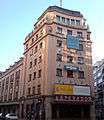
Emperador Theatre.
References
 This article incorporates text from a publication now in the public domain: Smith, William, ed. (1854–1857). "article name needed". Dictionary of Greek and Roman Geography. London: John Murray.
This article incorporates text from a publication now in the public domain: Smith, William, ed. (1854–1857). "article name needed". Dictionary of Greek and Roman Geography. London: John Murray.
Notes
- ↑ La Junta concede el título de 'Cuna del Parlamentarismo' a la ciudad de León
- ↑ According to the Spanish National Institute of Statistics, consulted on 2016
- ↑ "The Decreta of León of 1188 - The oldest documentary manifestation of the European parliamentary system". www.unesco.org. UNESCO.
- 1 2 Rabanal Alonso, Manuel Abilio (coord.) (1999). La Historia de León, Vol. 1: Prehistoria y Edad Antigua (in Spanish). Universidad de León. p. 189. ISBN 84-7719-817-9. Retrieved 18 November 2013.
- ↑ Itin. Ant. p. 395; Λεγίων ζ Γερμανική, Ptol. ii. 6. § 30
- ↑ Rabanal Alonso 1999, p. 192
- ↑ Dion Cass. iv. 24; Tac. Hist. ii. 11, iii. 25; Suet. Galba, 10.
- ↑ Respecting the use of which, and Gemella, see Caesar B.C. iii. 3
- ↑ Tac. Hist. ii. 11, 67, 86, iii. 7, 10, 21--25, iv. 39; Inscr. ap. Gruter, p. 245, no. 2.
- ↑ Muratori, p. 2037, no. 8, A.D. 130; p. 335, nos. 2, 3, A.D. 163; p. 336, no. 3, A.D. 167; Gruter, p. 260, no. 1, A.D. 216
- ↑ "Valores Climatológicos Normales. León, Virgen del Camino" (in Spanish). AEMet. Retrieved 4 May 2010.
- ↑ "Morala, R. (2004): Norma y usos gráficos en la documentacion leonesa. In: Aemilianese I, S. 405-429." (PDF). Retrieved 2011-04-10.
- ↑ Menéndez Pidal, R. "El Dialecto Leonés". Madrid. 1906
- ↑ "UNESCO Red Book on Endangered Languages: Europe". Helsinki.fi. Retrieved 2011-04-10.
- ↑ "Cuasi douscientos alunos estudiarán Llingua Llïonesa esti añu". Ayuntamiento de León. 14 November 2008. Archived December 4, 2009, at the Wayback Machine.
- ↑ "Una delegación leonesa inicia en Bragança el hermanamiento entre las ciudades – León". www.diariodeleon.es. 2006-02-20. Retrieved 2011-04-10.
- ↑ "Oporto | Portugal". Infoidiomas.Com. 2010-11-15. Retrieved 2011-04-10.
- 1 2 3 "Ciudades y pueblos se benefician del hermanamiento con otros territorios". Larazon.es. Retrieved 2011-04-10.
- ↑ "Xiangtan (China) se hermana con León y establece por primera vez colaboraciones con una ciudad europea". Retrieved 2010-11-18.
- 1 2 "León y Córdoba, hermanas" (in Spanish). Leonoticias. Retrieved 2010-01-23.
External links
- Basilica Saint Isidore of Leon
- León City Council (Spanish)
- Tourism in León (Spanish)
- León, northwest of Madrid...
- Leon city guide at HitchHikers Handbook
- Leon on the Camino de Santiago
- Photos of the city of Léon
- Paradoxplace León Photo Pages
- Rural Tourism in León (Spanish)
- Interview with Agustín Pérez-Rubio, current director and former chief curator of the MUSAC
Coordinates: 42°36′20″N 5°34′12″W / 42.60556°N 5.57000°W
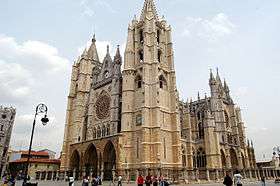
.svg.png)

